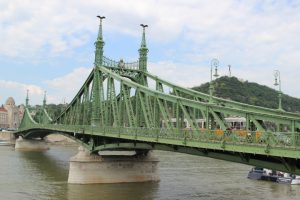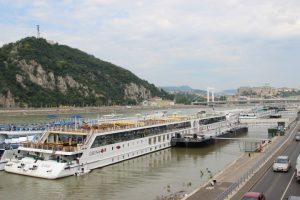Wednesday 10th June
Our hotel is near Kalvin ter and upon leaving at 9:30 a.m. it was already 24 degrees.
Budapest is thought by many to be the finest of three of the Habsburg Empire’s largest cities: Budapest, Vienna and Prague. It is essentially two cities split by the River Danube. Buda is on the hills to the west and Pest on the flat land to the east. Our hotel is in central Pest which is the city’s commercial hub. Most of the buildings date from the 19th century redevelopment. Where central Pest meets the river is the embankment walk which extends from the Liberty Bridge (the nearest to our hotel) to the Margaret Bridge at the northern end of Pest. The Liberty Bridge was first constructed between 1894 – 99, but is an exact replica today, the original having been destroyed in World War II.
Our walk along the embankment took us to the landing stages for river cruises near the Elizabeth Bridge. The bridge when completed in 1903 was the longest in the world, but again had to be completely rebuilt after the war and it did not reopen until 1963. En route we passed the famous restaurant Trattoria Toscana which has been in Budapest for 14 years and is apparently frequented by many famous people such as Formula One racing drivers.
Our river cruise took us north to Margaret Island and enabled us to clearly see the UNESCO World Heritage sights of Buda and the modern buildings of Pest. Upon return we ate in the shadow of the inner city parish church. This is Pest’s oldest church. The original Roman style structure was destroyed and replaced in the 14th century. It was nearly lost when the Elizabeth Bridge was rebuilt but luckily it survived. Our restaurant was called the Monk’s Bistrot and is at the east end of the church.
Our afternoon stroll took us through central Pest, in particular along the Vaci utca. This is a street in two parts, one end for shopping, the other for eating and drinking. At the Liberty Bridge end is the Central Market Hall. This is the city’s largest market with numerous stalls on the ground floor selling meat, fruit, vegetables and cheese, with tourist souvenirs on the upper level. The building is constructed from decorative brickwork and colourful roof tiles with a wrought iron interior.








